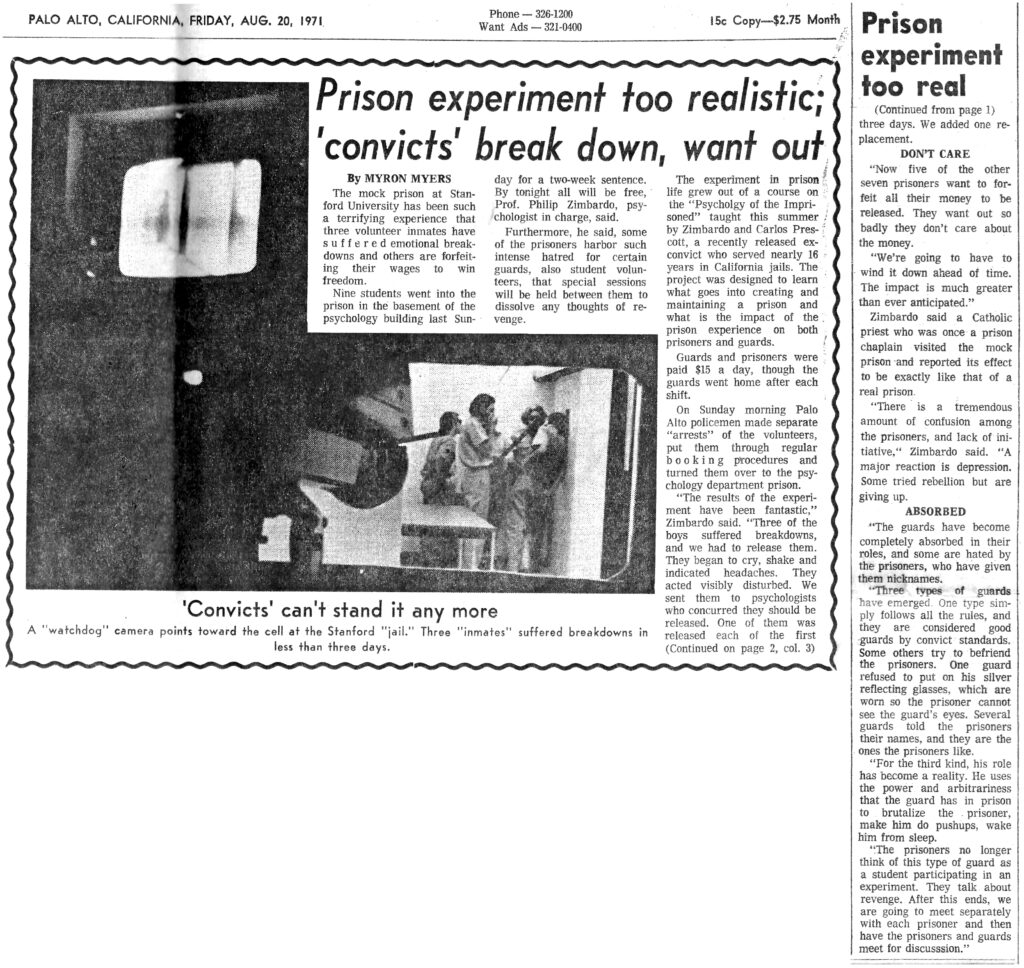The day the experiment ended the first stories of why it was stopped appeared.
(Click the image to open it. Scroll down for the transcribed text)

Prison Experiment Too Realistic. Convicts Breakdown Want Out.
by Myron Myers.
The mock prison at Stanford University has been such a terrifying experience that three volunteer inmates have suffered emotional breakdowns and others are forfeiting their wages to win freedom. Nine students went into the prison in the basement of the psychology building last Sunday for a two-week sentence. “By tonight, all will be free.” Professor
Philip Zimbardo, psychologist in charge, said. Furthermore, he said, some of the prisoners harbor such intense hatred for certain guards, also student volunteers, that special sessions will be held between them to dissolve any thoughts of revenge. The experiments in prison life grew out of a course on the psychology of the imprisoned, taught this summer by Zimbardo and Carlos Prescott, a recently released ex-convict who served nearly 16 years in California jails. The project was designed to learn what goes into creating and maintaining a prison and what is the impact of the prison experience on both prisoners and guards. Guards and prisoners were paid $15 a day, though the guards went home after each shift. On Sunday morning, Palo Alto policemen made separate arrests of the volunteers, put them through regular booking procedures and turned them over to the psychology department prison. “The results of the experiment have been fantastic,” Zimbardo said. “Three of the boys suffered breakdowns and we had to release them. They began to cry, shake and indicated headaches. They acted visibly disturbed. We sent them to psychologists who concurred they should be released. One of them was released. One of them was released each of the first three days. We added one replacement.
DON’T CARE
Now five of the other seven prisoners want to forfeit all their money to be released. They want out so badly they don’t care about the money. We’re going to have to wind it down ahead of time. The impact is much greater than ever anticipated.” Zimbardo said a Catholic priest who was once a prison chaplain visited the mock prison and reported its effect to be exactly like that of a real prison. “There is a tremendous amount of confusion among the prisoners and lack of initiative,” Zimbardo said. “A major reaction is depression. Some tried rebellion but are giving up.”
ABSORBED
“The guards have become completely absorbed in their roles and some are hated by the prisoners who have given them nicknames.” Three types of guards have emerged. One type simply follows all the rules and they are considered good guards by convict standards. Some others try to befriend the prisoners. One guard refused to put on his silver reflective sunglasses which are worn so the prisoner cannot see the guard’s eyes. Several guards told the prisoners their names and they are the ones the prisoners like. For the third kind, his role has become a reality. He uses the power and arbitrariness that the guard has in prison to brutalize the prisoner, make him do push-ups, wake him from sleep. The prisoners no longer think of this type of guard as a student participating in an experiment. They talk about revenge. After this ends, we are going to meet separately with each prisoner and then have the prisoners and guards meet for discussion.
